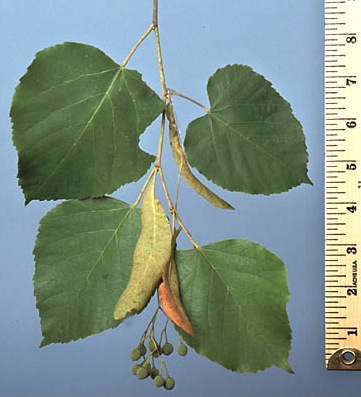This year I am following the tree at the end of the big lawn at Glen Villa, my garden in rural Quebec. The botanical name of the tree is Tilia americana. I call it a linden.
That’s not wrong — the tree is a member of the linden family. Like many living things, it goes by several names. In England, it is a lime tree. In North America it is commonly known as basswood.
Today I’m far from home, on holiday some 1800 kilometres/ 1100 miles to the south. So I can’t trudge across the snow to take a photo of the tree, I can’t inspect its bark or look to see if any buds are present. (Highly unlikely: the snow is several feet deep and temperatures are equivalently low.)
I do have photos of the tree, of course.

This is how the linden might be looking today. Notice the man next to it — he is about 6 ft tall. That gives you an idea of the height of the tree, which I estimate to be around 60 ft. tall.
Instead of inspecting the tree to find out what is happening to it, I read about it on line. To my delight, I learned a lot. The name basswood comes from bast, a plant fibre that is found in the inner bark of the tree. For centuries Native Americans and Europeans used the fibre to make ropes, nets, woven bags and coarse coverings — the Ainu people of Japan used it to weave their traditional coat-like garment, the attus. Indians used the fibres for fishnets, snowshoe netting, sewing thread and suturing wounds. So my linden is a useful tree as well as a beautiful one.
The bast, or fibres, of the linden are not as strong as those of flax and nettles, but they are longer and more abundant, and consequently easier to make into whatever cordage you need for bundling up light loads.. The tree is not into instant gratification, however — you have to soak the bark for two to four weeks to loosen the fibres. (So if you want some thread to stitch up a wound, you’d better have it on hand.)
As for the name ‘lime,’ Wikipedia tells me that it is an altered form of the Middle English word lind, making its connection to linden obvious. Apparently it is cognate to, or has the same linguistic derivation as, the Latin word lentus, meaning flexible. Linden was originally an adjective meaning ‘made from lime-wood,’ making it equivalent to ‘wooden.’
As for the botanical name Tilia, it is cognate to Greek words meaning elm tree, or black poplar, and before that to a Proto-Indo-Eurpean word that meant simply broad — appropriate therefore to the broad leaves of my lime/basswood/linden.
Searching on line, I learned that these leaves make sweet salad greens when young and tender, just after the buds open in spring. The Ojibwa ate the young buds raw or cooked as greens and they boiled down the sweet sap to a syrup. The cambium, that part of the tree between the outer bark and the wood, is moist and tastes of cucumber in springtime. According to forager Green Deane, it is “good for soups or when dried can be powdered and used for bread. You can also eat it raw off the tree, the least amount of work for the nutrition and flavor…. While the flowers are edible raw or cooked a tea can be made from them. Two tablespoons per cup.”
My linden has one more name — the ‘bee tree’ — and that name for me needs no explanation. The American linden is not as highly scented as the European version but the blossoms do produce a sweet perfume. In mid summer bees swarm to collect the nectar. Sitting then on the bench under my tree is like sitting inside the bee hive, with warm contentment buzzing all around. A perfect end to a summer’s day.








I do hope upon your return you will lash on the snowshoes and get us a fresh picture!
Snowshoes will be lashed, photos will be taken!
I remember this photograph from last year when you were saying which trees in your garden you like (as opposed to the little one you were then following which you didn’t!). I’m sort of glad you weren’t able to be there in person to observe it this month because it has led you to introduce it in such an interesting and jam-packed-informative way. I didn’t know any of those things – except how much bees love it. I remember walking down an avenue of lime trees and being confused about the roaring noise. Where was it coming from? The bees in the trees! Incredible. (I think limes also drip so much stickiness it wouldn’t be the best of ideas to put a garden bench in their shade. Is that right?)
Hope you enjoyed your holiday. Safe return.
Lucy, you obviously have a good visual memory since you remember the photo I used! You also must take a lot of time reading and responding to all the entries. I admire both qualities. As for stickiness — the basswood version of a Tilia must not give off as much stickiness as your lime trees. There are occasional sticky spots but not many, and definitely not enough to offset the pleasure of sitting on the bench. PS: The holiday is great — a nice spot and no snow! That’s key since people in the northeast are digging out daily.